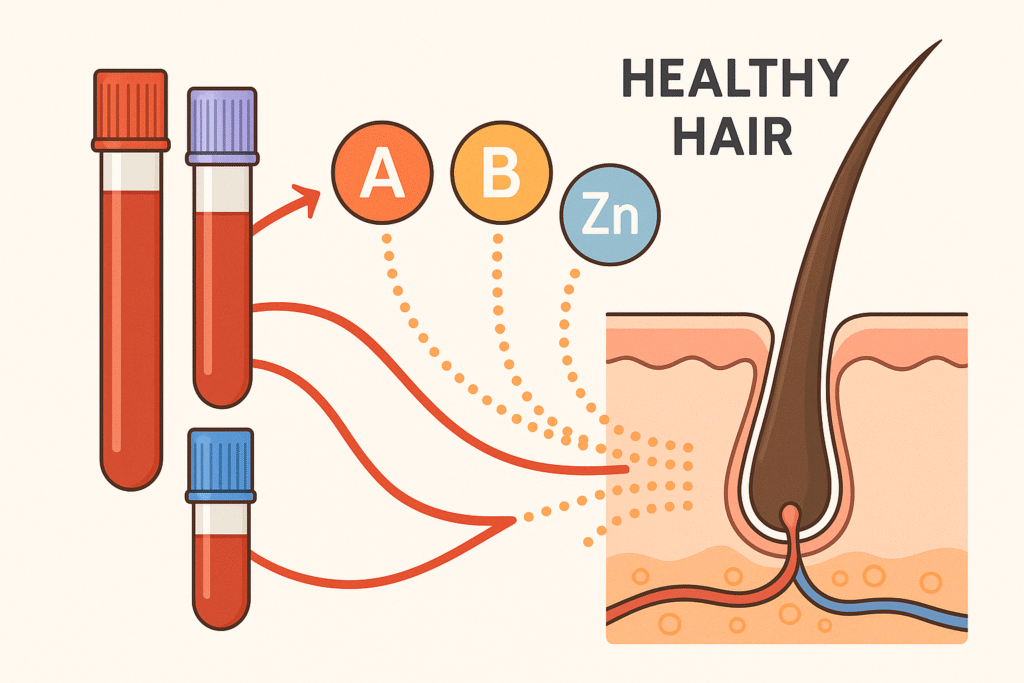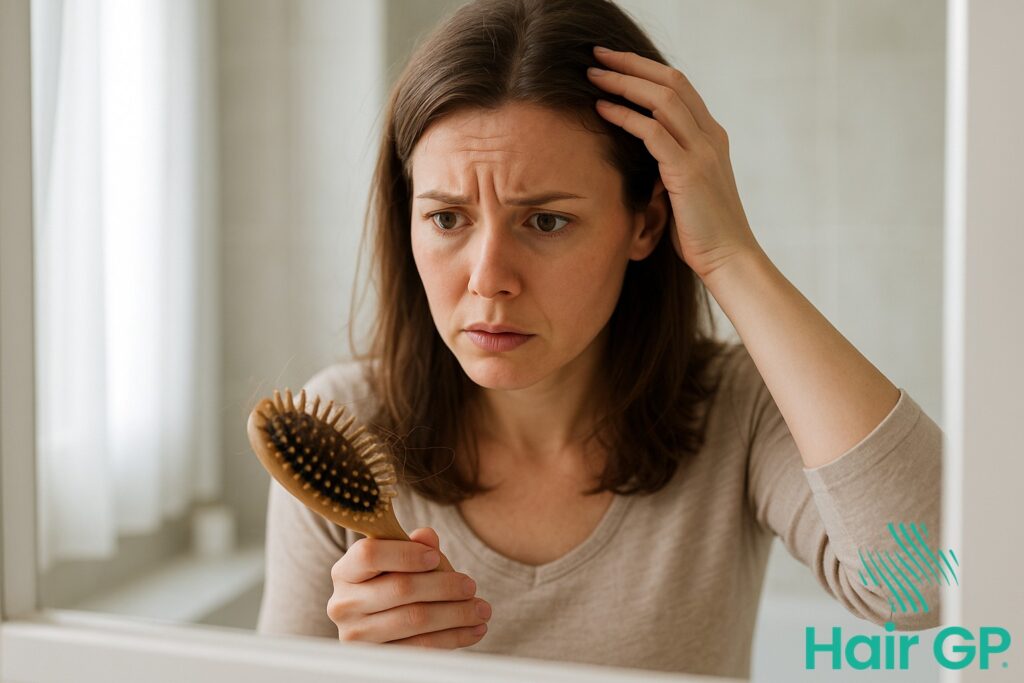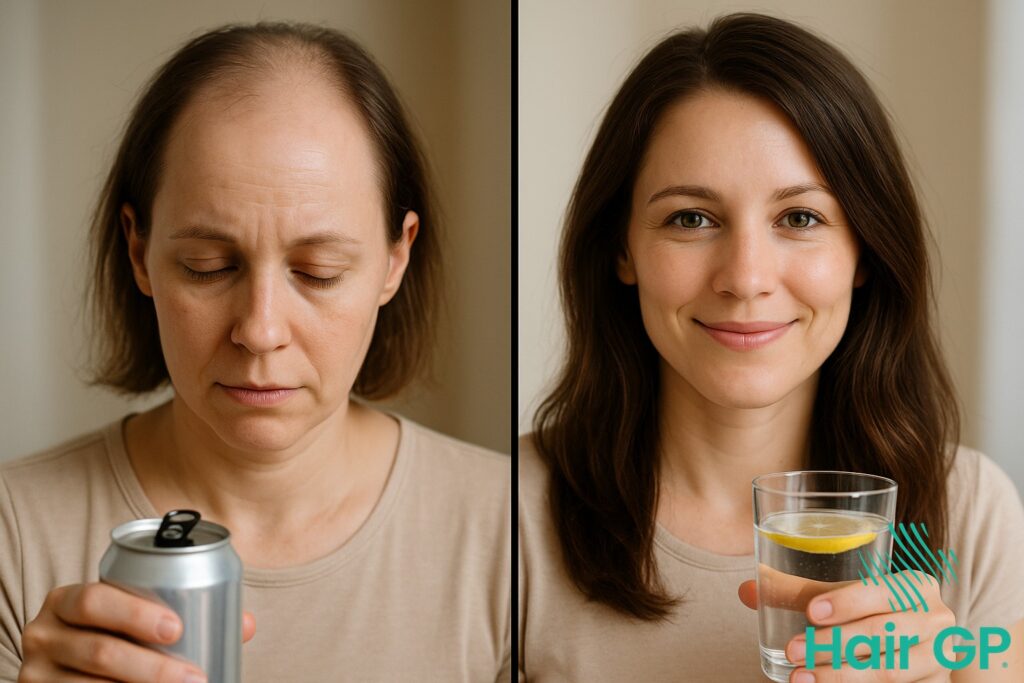Introduction
Hair loss can be one of the most frustrating experiences, leaving you searching for answers while watching your hairline recede or noticing increased shedding in the shower. The good news? Your blood test results often hold the key to understanding what’s really happening beneath the surface. Rather than guessing at causes or trying endless products, diagnosing hair loss through comprehensive blood testing provides a scientific foundation for addressing the root cause of your hair concerns.
This comprehensive guide decodes the essential blood markers that directly impact hair health—ferritin levels, B12, and vitamin D—helping you understand exactly what your lab results mean and how vitamin deficiencies contribute to hair thinning, excessive hair fall, and poor hair growth. When these crucial nutrients fall below optimal levels, your hair follicles simply cannot function properly, leading to weakened strands, slower growth cycles, and noticeable hair loss.
Throughout this guide, we’ll explore the scientific connection between specific blood markers and hair health, diving deep into how iron and ferritin affect your follicles, why B vitamins are essential for strong hair growth, and how vitamin D deficiency can trigger various forms of alopecia. You’ll also discover additional important markers to consider, learn how to interpret your results with confidence, and understand when it’s time to get tested. By the end, you’ll have the knowledge to work effectively with your healthcare provider and take targeted action based on your unique blood chemistry.
Key Takeaways – TL/DR
- Ferritin levels below 30-40 ng/mL can trigger hair loss even when iron levels appear normal
- B12 deficiency affects hair follicle health and can cause premature graying and thinning
- Vitamin D levels under 30 ng/mL are linked to alopecia and poor hair growth cycle function
- A complete blood count with additional markers provides the most comprehensive hair loss diagnosis
- Early detection through blood tests enables targeted treatment before permanent hair damage occurs
Understanding Blood Tests for Hair Health
Blood tests serve as powerful diagnostic tools that reveal the underlying biochemical factors affecting your hair health. Common blood tests can identify nutritional deficiencies, hormonal imbalances, and metabolic issues that directly impact hair growth cycle phases and follicle function. Understanding blood analysis results provides healthcare providers with essential data to develop targeted approaches for healthy hair growth restoration.
The Science Behind Blood Work and Hair Growth
Your hair follicles depend entirely on nutrients delivered through blood circulation to sustain the complex hair growth cycle, which spans approximately 2-7 years depending on genetic factors [1]. During the anagen (growth) phase, follicles require a steady supply of proteins, vitamins, minerals, and oxygen carried by your bloodstream. When blood tests reveal deficiencies in key nutrients like iron, vitamin D, or B-complex vitamins, these shortages directly compromise follicle function. The impact timeline varies, but nutritional deficiencies typically begin affecting hair health within 2-3 months, as the hair growth cycle responds to changes in nutrient availability. Blood analysis can detect these deficiencies before visible hair loss occurs, enabling early intervention.
Essential Blood Tests for Hair Loss Diagnosis
Several blood tests provide crucial insights into hair health status and potential causes of hair loss. A complete blood count (FBC) reveals overall health markers and can identify anaemia, which affects approximately 25-30% of individuals experiencing hair loss [2]. Ferritin testing measures iron storage levels, as iron deficiency is among the most common nutritional causes of hair thinning. Comprehensive vitamin panels assess B-vitamins, vitamin D, and other nutrients essential for follicle function. Thyroid function tests evaluate TSH, T3, and T4 levels, as thyroid disorders significantly impact hair growth patterns. These common blood tests work together to create a complete picture of the internal factors affecting your hair health, guiding Doctors toward accurate diagnosis and appropriate interventions.

Ferritin and Iron Levels Explained
Ferritin testing provides crucial insights into your body’s iron storage capacity and directly correlates with hair follicle health. Understanding the relationship between ferritin levels, serum ferritin measurements, and hair loss patterns enables targeted treatment approaches for iron deficiency-related hair concerns.
What Ferritin Levels Mean for Your Hair
Optimal ferritin levels for healthy hair growth typically range between 40-70 ng/mL, though research suggests levels above 40 ng/mL are necessary to prevent hair loss [1]. When ferritin levels drop below 30 ng/mL, many individuals experience diffuse hair thinning, increased shedding, and reduced hair diameter. Low ferritin levels create a cascade effect where hair follicles enter pre-mature telogen phase, resulting in widespread hair loss patterns that affect the entire scalp rather than specific areas. Iron deficiency affects approximately 72% of women experiencing hair loss, making it one of the most common underlying causes [3].
Serum Ferritin vs. Other Iron Tests
Serum ferritin represents the most accurate single marker for assessing iron stores relevant to hair health, as it reflects long-term iron availability rather than short-term fluctuations. While transferrin saturation and total iron binding capacity provide additional context, serum ferritin specifically measures stored iron that hair follicles access during growth phases. Other iron tests like serum iron can vary significantly throughout the day, making ferritin levels the gold standard for diagnosing iron deficiency-related hair loss.
Iron Storage and Hair Follicle Function
Hair follicles require substantial iron reserves to support the rapid cell division necessary for hair growth. Low iron disrupts this process by limiting oxygen transport to follicle cells and reducing the efficiency of cellular energy production. When iron levels become insufficient, follicles prioritize essential bodily functions over hair growth, leading to follicle miniaturization and eventual hair loss. The stored iron measured by ferritin testing directly impacts follicle metabolism and determines whether adequate resources exist for maintaining healthy hair growth cycles.

B12 and B Vitamins Testing
B vitamins play crucial roles in cellular metabolism and hair follicle function, making comprehensive testing essential for identifying underlying causes of hair loss and poor hair quality. B vitamin deficiencies can significantly impact hair growth cycles, colour production, and overall follicle health, requiring targeted testing to develop effective treatment strategies.
B12 Testing and Hair Health
Vitamin B12 deficiency affects approximately 6% of adults under 60 and up to 20% of those over 60 [4], making it a critical marker in hair health assessments. B12 plays essential roles in DNA synthesis and red blood cell formation, directly impacting hair follicle cell division and oxygen delivery to hair roots. Deficiency symptoms often manifest as hair thinning, brittle texture, and premature greying, as B12 is necessary for melanin production in hair follicles.
B12 testing involves measuring serum B12 levels, though methylmalonic acid and homocysteine tests provide more accurate assessments of functional B12 status. Normal B12 levels range from 200-900 pg/mL, but levels below 400 pg/mL may still cause hair-related symptoms. The connection between B12 deficiency and premature greying has been documented in multiple studies, showing that adequate B12 levels help maintain natural hair pigmentation and support strong hair growth.
Folate and Biotin: Additional B Vitamin Markers
Folate deficiency directly impacts cell division processes essential for hair follicle regeneration and growth. Testing folate levels helps identify deficiencies that can cause hair thinning and slow growth rates. Normal folate levels should exceed 4 ng/mL for optimal hair health.
Biotin deficiency, while rare, can cause significant hair loss and brittleness. Research shows biotin supplementation may improve hair growth in individuals with documented deficiencies [5]. Testing is recommended when other vitamin deficiencies are ruled out, as biotin works synergistically with other b vitamins to promote strong hair and healthy follicle function.
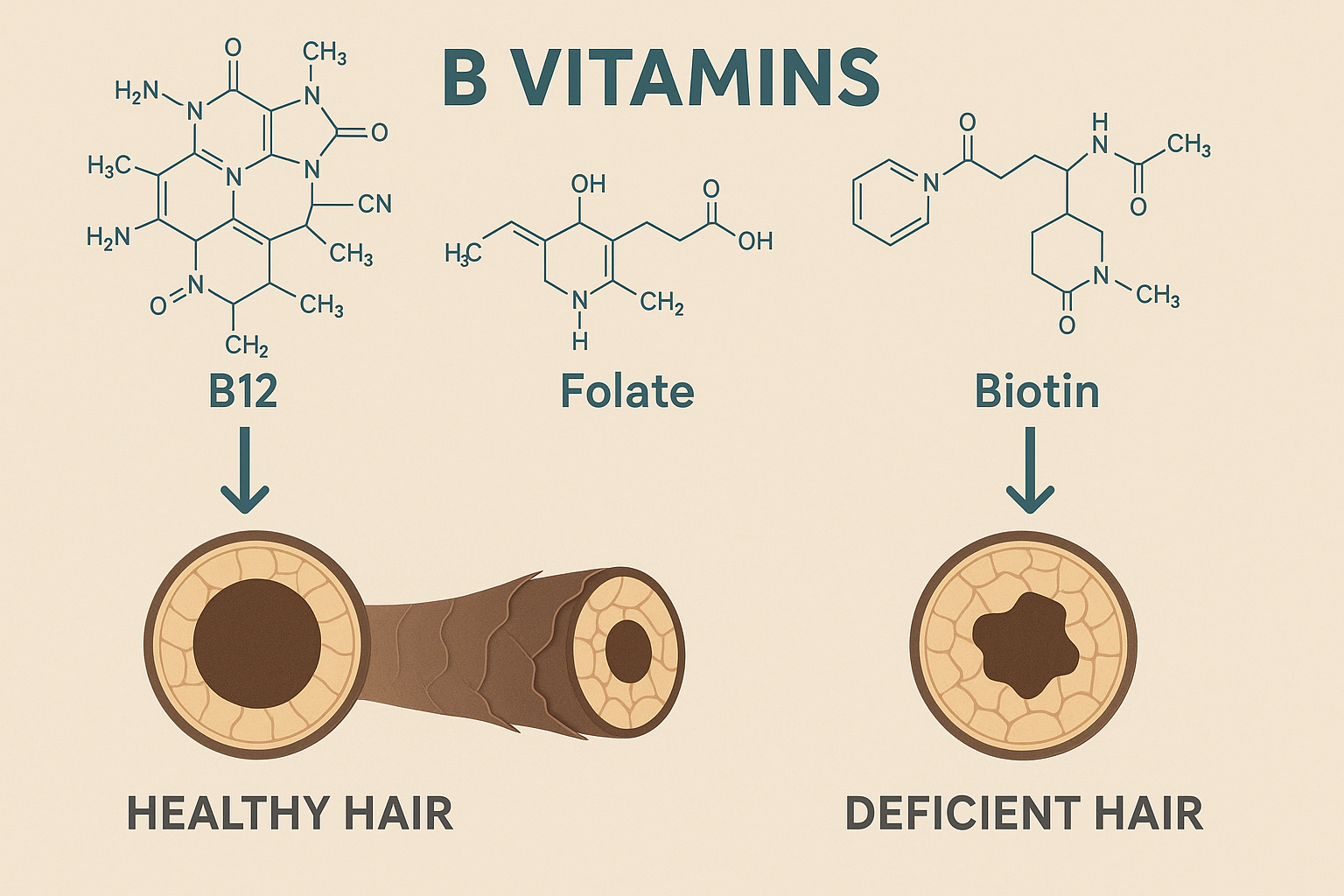
Vitamin D and Hair Connection
Vitamin D testing plays a critical role in evaluating hair health, as this essential hormone directly influences hair follicle function and the hair growth cycle. Research demonstrates that vitamin D deficiency affects nearly one billion people worldwide [6] and significantly impacts various forms of hair loss. Understanding the connection between vitamin D levels and healthy hair provides valuable insights for both diagnosis and treatment of alopecia conditions.
Optimal Vitamin D Levels for Hair Growth
Optimal vitamin D levels for supporting healthy hair typically range between 30-50 ng/mL (75-125 nmol/L), with deficiency defined as levels below 20 ng/mL (50 nmol/L * this is the UK level you will see on your blood test). Hair follicles contain vitamin D receptors that regulate the hair growth cycle, making adequate vitamin D essential for proper follicle function. Testing should occur annually or bi-annually, particularly for individuals experiencing hair loss, as vitamin D deficiency can disrupt the anagen phase of hair growth and lead to premature follicle regression.
Vitamin D Deficiency and Alopecia Types
Vitamin D deficiency contributes to multiple types of hair loss conditions through various mechanisms. Research indicates a strong association between low vitamin D levels and alopecia areata, with studies showing significantly lower serum vitamin D concentrations in affected patients [7]. Female pattern hair loss also demonstrates correlation with vitamin D deficiency, as inadequate levels can accelerate follicle miniaturization. Additionally, vitamin D deficiency may trigger telogen effluvium by disrupting normal hair follicle cycling, causing premature transition of hair follicles from the growth phase to the resting phase, resulting in diffuse hair shedding.

Additional Blood Markers to Consider
Beyond the primary triad of iron studies, vitamin D, and hormone panels, several additional blood markers provide crucial insights into hair loss aetiology. Comprehensive evaluation includes thyroid function tests, inflammatory markers, and trace element assessments to identify underlying conditions affecting follicular health.
Thyroid Function and Hair Health
Thyroid hormones directly regulate hair follicle cycling, making thyroid function tests essential in hair loss evaluation. TSH testing serves as the initial screening tool, with elevated levels indicating hypothyroidism present in approximately 15% of hair loss patients [1]. Complete assessment requires measuring free T3 and T4 levels, as subclinical thyroid dysfunction can manifest as hair thinning despite normal TSH. Thyroid autoantibodies, including anti-TPO and anti-thyroglobulin, help identify autoimmune thyroid conditions that frequently correlate with alopecia areata and diffuse hair loss patterns.
Inflammatory Markers and Hair Loss
Chronic inflammation significantly impacts follicular function, making inflammatory markers valuable diagnostic tools. C reactive protein elevation indicates systemic inflammation that can disrupt normal hair cycling and contribute to telogen effluvium. Full blood count analysis reveals inflammatory patterns through elevated white cell counts and altered neutrophil-to-lymphocyte ratios. Autoimmune markers, including ANA and specific autoantibodies, help identify conditions like lupus and dermatomyositis that commonly present with hair loss as an early symptom.
Zinc and Other Trace Elements
Zinc levels require assessment when clinical signs suggest deficiency, as inadequate zinc affects keratin synthesis and follicular health [2]. Copper testing complements zinc evaluation, since zinc supplementation can induce copper deficiency. Selenium levels, though less commonly tested, play important roles in antioxidant protection of hair follicles and may warrant evaluation in patients with concurrent autoimmune conditions or significant oxidative stress markers.

Reading and Interpreting Your Results
Understanding your blood test results is crucial for identifying the root causes of hair issues and determining when intervention may be necessary. While medical laboratories provide standard reference ranges, these may not reflect optimal levels for hair health, requiring a more nuanced interpretation of your bloodwork for effective hair loss diagnosis. That’s why at Hair GP we are always happy as part of a medical consultation to run through any tests you may have done privately or via the NHS.
Understanding Reference Ranges vs. Optimal Levels
Standard laboratory reference ranges represent values found in 95% of the general population, but these ranges may not indicate optimal levels for better hair health. For hair loss diagnosis, practitioners often look for values in the upper portion of reference ranges rather than simply “normal” results. For example, while ferritin levels above 15 ng/mL are considered normal, hair health specialists typically recommend levels above 50-70 ng/mL for optimal hair growth. Your blood analysis should be interpreted with hair-specific targets in mind, as different laboratories may use varying reference ranges and testing methodologies that can affect result interpretation. Understanding these nuances helps you advocate for more thorough evaluation when your blood sample results fall within normal ranges but remain suboptimal for hair health.
Red Flags in Your Blood Work
Several patterns in your blood test results may indicate higher likelihood of nutrient-related hair loss. Multiple deficiencies appearing simultaneously often suggest absorption issues or dietary inadequacy that could significantly impact hair health. Borderline results, even when technically within normal ranges, may warrant attention when combined with hair loss symptoms. Pay particular attention to trending patterns if you have multiple blood samples over time – declining levels of key nutrients like iron, vitamin D, or B vitamins can predict hair problems before they become clinically apparent. Values in the lower third of reference ranges for hair-critical nutrients should be considered potential amber flags, especially when accompanied by visible hair changes or family history of hair loss. Additionally, inflammatory markers like elevated C-reactive protein alongside nutrient deficiencies may indicate underlying conditions affecting both overall health and hair growth.

When to Get Tested and Next Steps
Knowing when to seek blood work for hair loss concerns and understanding the follow-up process can significantly impact treatment success. Proper timing of tests and effective communication with healthcare providers ensures comprehensive evaluation and appropriate monitoring of your hair restoration journey.
Optimal Testing Timeline
Schedule initial blood work as soon as you notice persistent hair thinning or increased hair fall lasting more than three months. For female pattern hair loss evaluation, timing isn’t critical, but testing during stable health periods provides the most accurate baseline results. Avoid testing during illness, pregnancy, or significant life stressors when possible.
Re-test intervals depend on your specific conditions and treatments. Thyroid function typically requires monitoring every 6-12 weeks initially when titrating medications, then every 6 months once stable. Iron levels should be rechecked 8-12 weeks after starting iron supplements, as improvements take time to reflect in blood work. Vitamin D levels warrant retesting after 3 months of supplementation depending on how deficient you were.
Consider seasonal factors when interpreting results, as vitamin D levels naturally fluctuate throughout the year, typically reaching lowest points in late winter.
Working with Your Doctor
Prepare for appointments by documenting your hair loss timeline, family history, and any recent life changes. Request comprehensive testing rather than single markers, explaining how hair loss affects your quality of life. Many providers may initially dismiss hair concerns, so persistence and clear communication about your symptoms help advocate for thorough evaluation.
Discuss treatment options based on results, including supplementation protocols, lifestyle modifications, and monitoring schedules to track progress effectively.
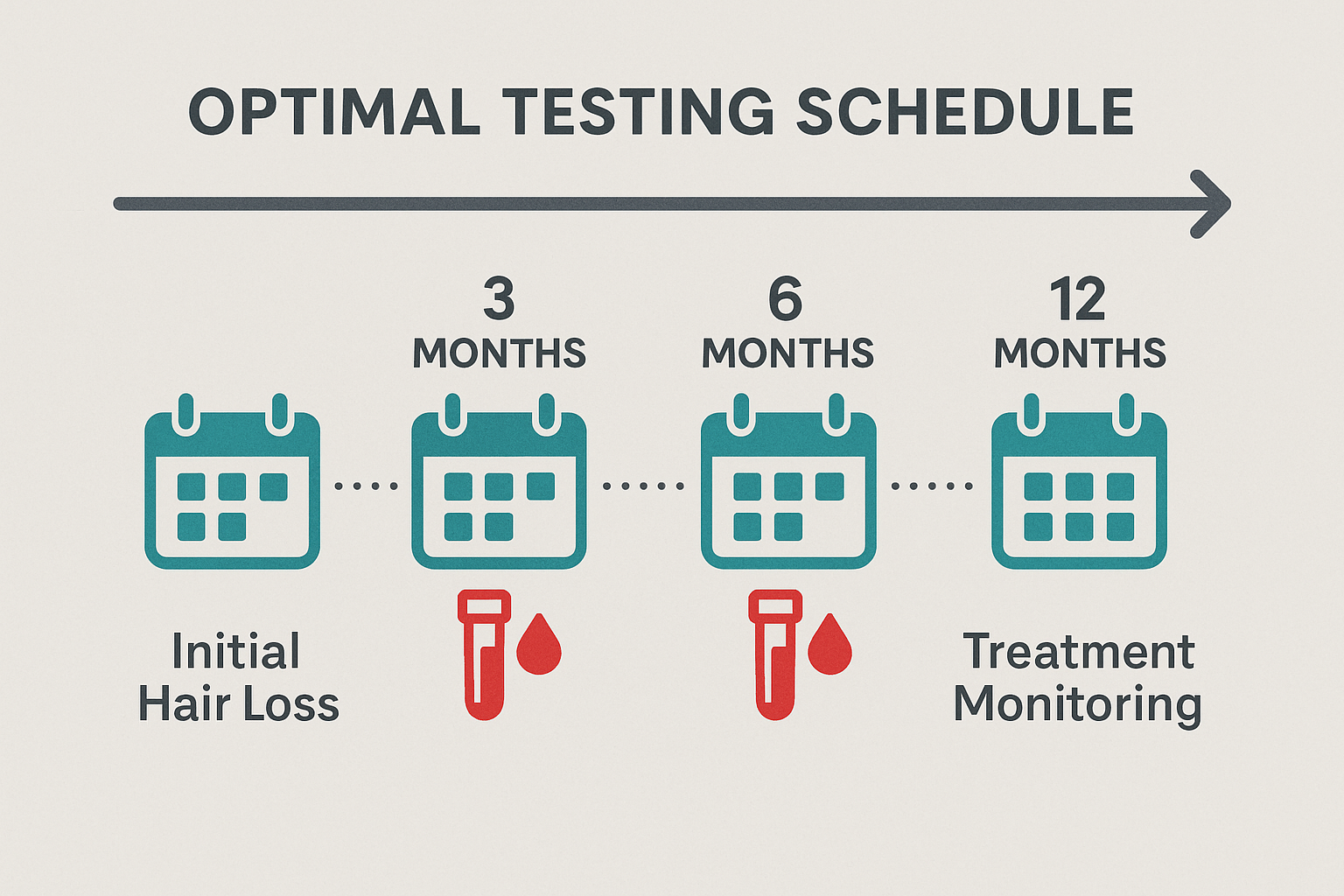
Conclusion
Understanding blood test results represents a crucial step in diagnosing hair loss and developing effective treatment strategies. Rather than guessing at potential causes, comprehensive testing reveals specific nutritional deficiencies that directly impact hair health, including low ferritin levels, vitamin B12 insufficiency, and vitamin D deficiency. These insights transform hair loss treatment from a trial-and-error approach to a targeted, evidence-based strategy.
When you receive your blood test results, you gain the power to work collaboratively with healthcare providers to address the underlying factors affecting your hair growth. This scientific approach enables personalized treatment plans that target root causes rather than merely managing symptoms, leading to more sustainable improvements in hair health.
The journey toward better hair health begins with accurate diagnosis through proper testing. By identifying and correcting nutritional imbalances, individuals can support healthy hair growth at the cellular level, promoting stronger follicles and improved hair density. Regular monitoring through follow-up blood tests ensures that treatment adjustments can be made as needed, optimizing outcomes for long-term hair health success and preventing future hair loss episodes.
Frequently Asked Questions
Yes, standard reference ranges for nutrients like ferritin may be too low for optimal hair health. Ferritin levels that appear ‘normal’ at 15-20 ng/mL can still cause hair loss, as hair follicles typically need levels above 30-40 ng/mL to function optimally.
Hair improvement typically takes 3-6 months after correcting nutrient deficiencies, as the hair growth cycle must complete its phases. New hair growth may be visible in 2-3 months, but significant improvement in hair density and quality usually requires 6-12 months of consistent treatment.
Yes, testing before supplementation is crucial for safety and effectiveness. Some supplements like iron can be harmful if you don’t have a deficiency, while others may mask underlying conditions. Blood tests help target specific deficiencies and establish baseline levels for monitoring progress.
A Full blood count plus specific tests for ferritin, B12, vitamin D, and thyroid function provides the most comprehensive hair loss evaluation. The full blood count can reveal additional issues like anaemia or inflammatory conditions that might contribute to hair problems.
References
- Almohanna HM, Ahmed AA, Tsatalis JP, Tosti A. The Role of Vitamins and Minerals in Hair Loss: A Review. Dermatol Ther (Heidelb). 2019;9(1):51-70.
- Guo EL, Katta R. Diet and hair loss: effects of nutrient deficiency and supplement use. Dermatol Pract Concept. 2017;7(1):1-10.
- Trost LB, Bergfeld WF, Calogeras E. The diagnosis and treatment of iron deficiency and its potential relationship to hair loss. J Am Acad Dermatol. 2006;54(5):824-44.
- Allen LH. Biomarkers of Nutrition for Development (BOND): Vitamin B-12 Review. J Nutr. 2012;142(11):1711S-1718S.
- Patel DP, Swink SM, Castelo-Soccio L. A Review of the Use of Biotin for Hair Loss. Skin Appendage Disord. 2017;3(3):166-169.
- Amrein K, Scherkl M, Hoffmann M, et al. Vitamin D deficiency 2.0: an update on the current status worldwide. Eur J Clin Nutr. 2020;74(11):1498-1513.
- Akar A, Akbaba G, Ozkaya DB, et al. Vitamin D levels in patients with alopecia areata. An Bras Dermatol. 2019;94(1):12-15.

